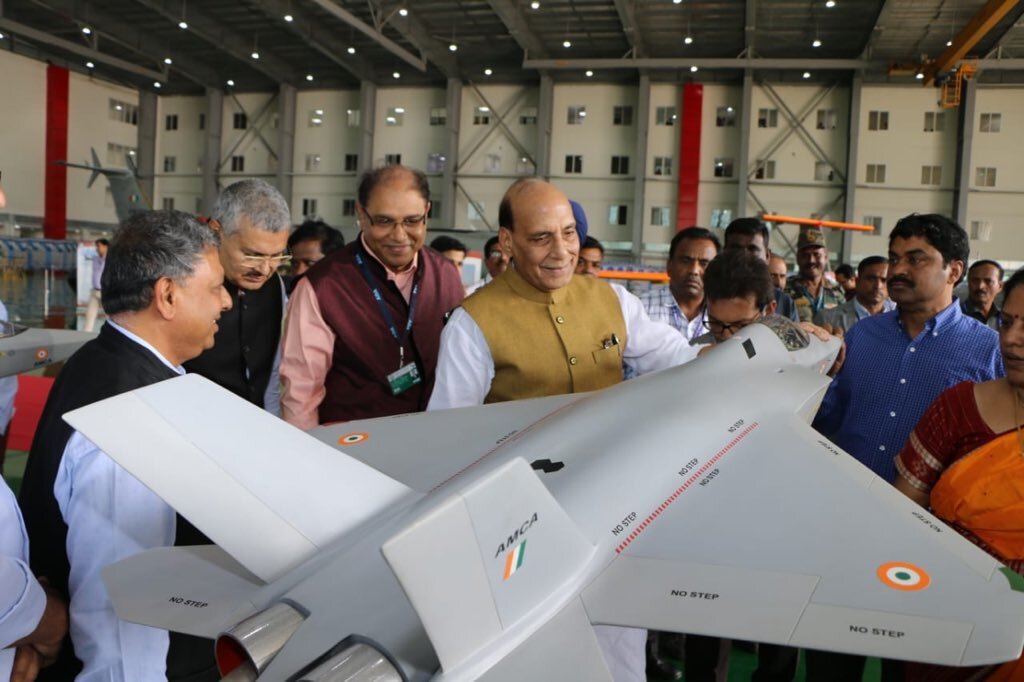The Indian government is expected to grant approval to the Indian Air Force’s (IAF’s) Advanced Medium Combat Aircraft (AMCA), the country’s fifth-generation fighter program, in the second half of 2021.
India’s Defence Research and Development Organisation (DRDO) has set an aggressive target for the program, with the futuristic stealth aircraft going into production by 2027 to 2030, according to a statement from IAF chief RKS Bhaduaria earlier this year.
Talking to Hindustan Times in February this year, Bhaduaria didn’t rule out the possibility of the stealth fighter being equipped with directed energy weapons, including the integration of sixth-generation technologies and superior anti-missile systems.
AMCA will come with fifth-generation stealth design features, although “a lot more can happen with the sensors, weapons, overall reach, and the aircraft’s capability,” he added.
IAF plans to deploy around 120 stealth aircraft to its fleet by 2032 when AMCA is expected to be ready for induction. Stealth will form an important element of air combat, with the dominance of electromagnetic warfare playing a central role in future warfare.
Assisted through AI-based systems, AMCA will come with multi-sensor data fusion (MSDF) and 3D audio for enhanced situational awareness, characteristic of fifth-generation warfare.
The homegrown fifth-generation fighter will also feature an advanced cockpit with a large area display (LAD), touchscreen, and 3D display for an excellent user interface.
Additionally, AMCA will be equipped with a quadruplex digital fly-by-wire control system with a HOTAS-configured side-stick controller and unified throttle for a smooth flying experience.

The country’s Aeronautical Development Agency (ADA), which is handling the AMCA development program, has chosen the 99 F414 GE jet engine to power the first two squadrons, the next two are expected to use the indigenous engine. 99 F414 GE was also chosen to power the Mk-II version of the Tejas Light Combat Aircraft (LCA).
With the development of the country’s indigenous Kaveri engine halted due to technological challenges, DRDO is reportedly setting up a separate facility to develop the engine for AMCA.
Scientists at the organization are faced with the daunting task of developing a completely new engine to suit the fifth-generation fighter, with the capability to produce a thrust of 110-kilo newton (kN).
While multiple global defense companies have approached India for collaboration to build the engine, the country is reportedly considering a partnership with France’s Dassault, which is also said to have offered technology transfer.
“We are signing an agreement related to the technology needed for high thrust engine manufacturing. The technology will be common to the Rafale engines that can be supported by us and would also be useful for the 110 kN engine project,” HAL Chairman was quoted by Economic Times as saying in October last year.
The #AMCA teaser by @Kuntal__biswas
Courtesy : @BlehDFI pic.twitter.com/mZOwez1qSA
— Indian Defence (@defence_in) April 5, 2021
The other notable characteristics of AMCA will be the incorporation of supersonic cruise and three-dimensional thrust-vectoring engines for super-maneuverability (expected to come up after initial two squadrons).
It was announced last year that the fighter program will be developed in a joint venture with a private company, a decision that came as a surprise for many as no fighter program has involved private partners so far.
According to reports, AMCA will be developed through a public-private partnership between India’s DRDO, Hindustan Aeronautics Limited (HAL), and a private company, the approval of which is being sought with the government.
The AMCA project is currently being pursued at the ADA’s Bengaluru campus, with leading defense sources claiming the HAL has been kept out of the development of the fifth-generation fighter, although the country’s premier aviation organization will take over the production once the prototype is ready.
The involvement of the private sector is thought to have been necessitated by the need to meet tight production deadlines and build a huge number of aircraft, including LCA Tejas Mk.1A/2A, AMCA, HAL Twin Engine Deck Based Fighter (TEDBF).
The participation of the private sector can help lessen the burden on HAL and DRDO which are already involved with the development of various fighter jet programs.
Model of AMCA in Aero India 2021 pic.twitter.com/PxGXsjAv4S
— Indian Defence (@iamindian64) February 3, 2021
“While we are supportive of DRDO & HAL’s efforts, the numbers involved indicate that involvement of the private sector in manufacturing is essential to ensure timely delivery of indigenous platforms.
We are already low in squadron numbers, & cannot afford to lose our operational potential if our numbers continue to fall,” the Air Chief had told a magazine in February this year.
He said the air force was “committed to the development of the LCA versions in parallel to fifth-generation AMCA which will be the mainstay of the IAF fighter fleet in the coming decades.”
With IAF critically low in squadron numbers, the force is looking to multiple options and the involvement of many stakeholders – public and private – to maintain a high production capacity.
“Involvement of the private sector in both design and development and manufacture of military aerospace platforms is critical for the development of a sustainable, cost-effective and efficient aerospace industry within the country,” Bhaduaria added.
The development of a fifth-generation aircraft (FGFA) will place India in a select list of countries with the ability to design, develop and operate such fighters. There are only four combat-ready FGFA aircraft in the world today – Lockheed Martin’s F-22 Raptor & F-35 Lightning II, Chinese Chengdu J-20 and Russian Su-57.
Follow EurAsian Times on Google News